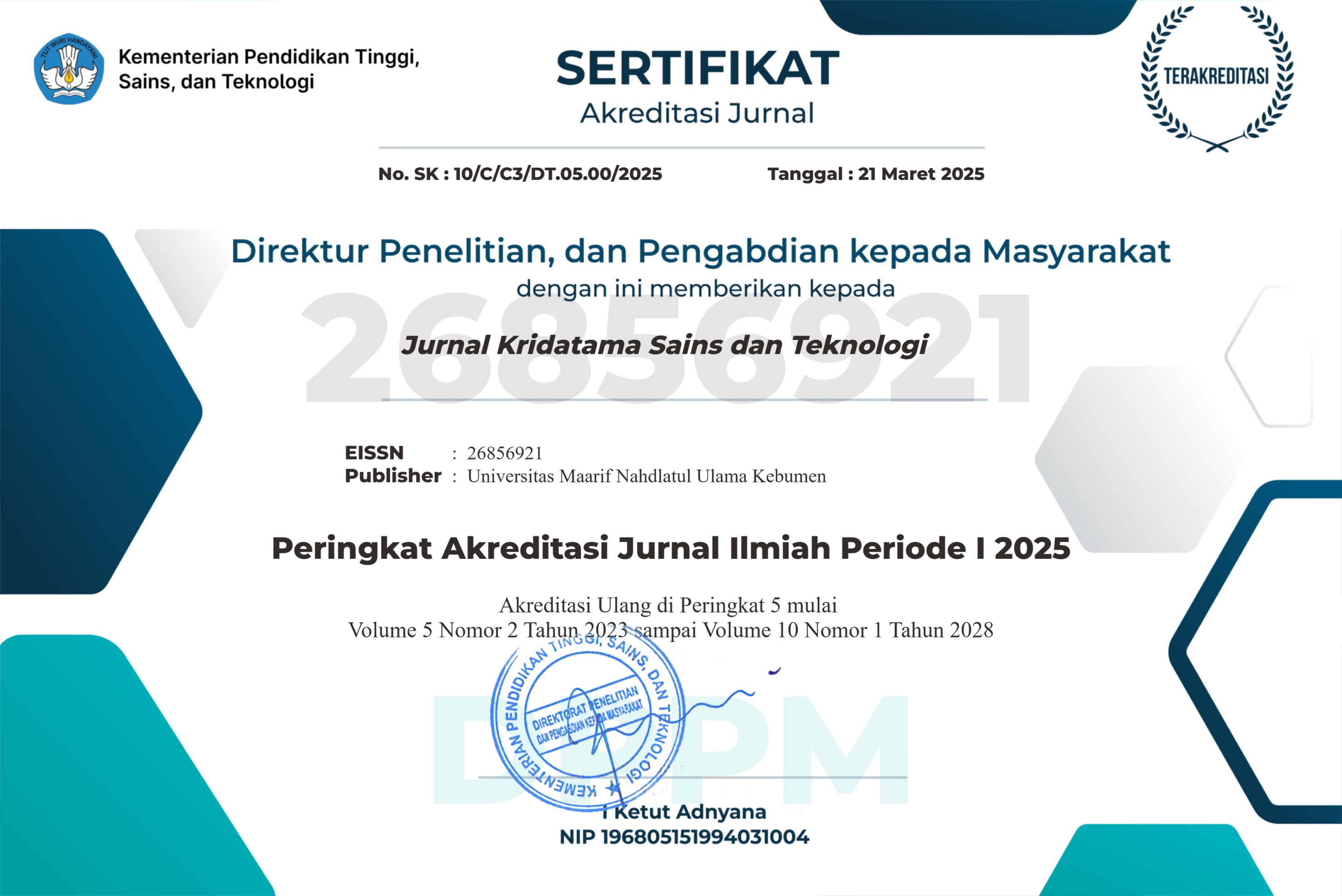Potensi Pemanfaatan Limbah Plastik HDPE Sebagai Bahan Aditif untuk Meningkatkan Kinerja Perkerasan AC-BC
DOI:
https://doi.org/10.53863/kst.v7i01.1660Keywords:
AC-BC, Asphalt concrete, HDPE, Flexible pavement, Marshall testAbstract
Flexible pavement construction widely employs asphalt as the primary binding material due to its ability to coat aggregates and form a strong, cohesive structure. However, the growing demand for asphalt and rising prices driven by global oil market fluctuations pose significant challenges to its availability. Therefore, alternative solutions are needed to reduce reliance on pure asphalt while enhancing the performance of asphalt mixtures. One promising alternative is the utilization of waste plastic in the form of High Density Polyethylene (HDPE), which has been shown to improve mixture stability, resistance to permanent deformation (rutting), and durability against moisture damage, while also contributing to sustainable waste management. This study aims to evaluate the effect of HDPE addition on the characteristics of Asphalt Concrete - Binder Course (AC-BC) mixtures. Based on the volumetric and mechanical analysis of the AC-BC mixture, adding HDPE increases stability and density with a decrease in VMA and VIM and an increase in VFA. Stability increases significantly up to 12%, but flow exceeds the specification limit at a content of ≥8%, and the Marshall Quotient decreases, indicating a decrease in stiffness. According to the Bina Marga specification (2018), the maximum HDPE content meets the requirements is 4%. A multi-criteria approach is needed to determine the best HDPE content that balances strength, flexibility, and long-term deformation resistance
References
Adibroto, F., Ali, S., Fauzi, A., Padilah, I., Padang, P. N., Manis, L., & Barat, S. (2022). Kinerja Campuran Asphalt Concrete Wearing Course Mengunakan Aspal Modifikasi Dengan Limbah Plastik Latar Belakang yang dipadatkan di atas tanah dasar supaya lalu lintas dapat berjalan dengan lancar Kelelehan ( Flow ), VIM , VMA , MQ dan Stabilitas Marshal. 12(1), 267–280.
Ahmadinia, E., Zargar, M., Karim, M. R., Abdelaziz, M., & Shafigh, P. (2011). Using waste plastic bottles as additive for stone mastic asphalt. Materials and Design, 32(10), 4844–4849. https://doi.org/10.1016/j.matdes.2011.06.016
Al Qurny, A. U., Hagni Puspito, I., & Tinumbia, N. (2022). Pengaruh Penambahan Bahan Pengisi (Filler) Fly Ash Terhadap Campuran Aspal Beton Lapis Aus (Asphalt Concrete Wearing Course/Ac-Wc). Jurnal ARTESIS, 2(1), 87–97. https://doi.org/10.35814/artesis.v2i1.3766
Direktorat Jenderal Bina Marga. (2020). Spesifikasi Umum 2018 (Revisi 2). Edaran Dirjen Bina Marga Nomor 02/SE/Db/2018, Revisi 2, 6.1-6.104.
Karyawan, I. D. M. A., Kencanawati, N. N., Hariyadi, H., Hasyim, H., & Rohani, R. (2023). Karakteristik Aspal Buton Ekstraksi yang Dimodifikasi dengan Oli Bekas dan Plastik HDPE. Rekonstruksi Tadulako: Civil Engineering Journal on Research and Development, 4(2), 79–86. https://doi.org/10.22487/renstra.v4i2.596
Machsus, M., Mawardi, A. F., Khoiri, M., Basuki, R., & Akbar, F. H. (2020). Analisa Pengaruh Variasi Temperatur Pemadatan Campuran Laston Lapis Antara (AC-BC) dengan Menggunakan Aspal Modifikasi. Jurnal Aplikasi Teknik Sipil, 18(1), 107. https://doi.org/10.12962/j2579-891x.v18i1.6215
Manurung, R. F., Arya Thanaya, I. N., & Tjerita, A. A. K. N. (2016). Karakteristik Campuran Aspal Emulsi Dingin Dengan Penggunaan Plastik Bekas Sebagai Pengganti Sebagian Agregat. Jurnal Ilmiah Elektronik Teknik Sipil, July, 1–23.
Mouwlaka, L. H. U. W., M. Sa’dillah, & Pandulu, G. D. (2024). Pengaruh Pengisian Rongga Campuran Aspal Porus Menggunakan Limbah Plastik Pet (Polyehylene Therephthalate). 8(1), 30–39.
Nurfadila, Mustakim, & Fadly, I. (2024). Perbandingan Kinerja Marshall Pada Campuran Aspal AC-WC Menggunakan Plastik Polypropilene (PP) Dan Plastik High Density Polyethylene (HDPE). Sultra Civil Engineering Journal (SCiEJ), 5(2), 363–373.
Puslitbang Teknologi Prasaranan Jalan Bandung Departemen Pemukiman dan Pengembangan Wilayah. (2003). Metode Pengujian Campuran Beraspal Panas dengan Alat Marshall. In Pustran-Balitbang PU.
Suhardi, Priyo, P., & Hadi, A. (2016). Studi Karakteristik Marshall Pada Campuran Aspal Dengan Penambahan Limbah Botol Plastik. Jrsdd, 4(2), 284–293.
Sumantoro, I. (2021). Harga Aspal Minyak Impor Naik, Siapa Peduli? Indonesiana. https://www.indonesiana.id/read/151013/harga-aspal-minyak-impor-naik-siapa-peduli
Sumiati, S., Mahmuda, M., & Syapawi, A. (2019). Perkerasan Aspal Beton (AC-BC) Limbah Plastik Hdpe Yang Tahan Terhadap Cuaca Ekstrem. Construction and Material Journal, 1(1), 1–11. https://doi.org/10.32722/cmj.v1i1.1322
Suprayitno, S., & Mudjanarko, S. W. (2020). Studi Analisis Uji Marshall Pada Pembuatan Campuran Aspal Plastik Jenis Hdpe. E-Jurnal SPIRIT PRO PATRIA, 5(2), 142–151. https://doi.org/10.29138/spirit.v5i2.1004
Tahir, A., & Setiawan, A. (2009). Kinerja Durabilitas Campuran Beton Aspal Ditinjau Dari Faktor Variasi Suhu Pemadatan Dan Lama Perendaman. Jurnal SMARTek, 7(1), 45–61.
Downloads
Published
How to Cite
Issue
Section
License
Copyright (c) 2025 I Dewa Made Alit Karyawan, Desi Widianty, Arlin Febriana

This work is licensed under a Creative Commons Attribution-ShareAlike 4.0 International License.
Authors retain copyright and grant the journal right of first publication with the work simultaneously licensed under a Creative Commons Attribution-ShareAlike 4.0 International License that allows others to share the work with an acknowledgment of the work’s authorship and initial publication in this journal

















